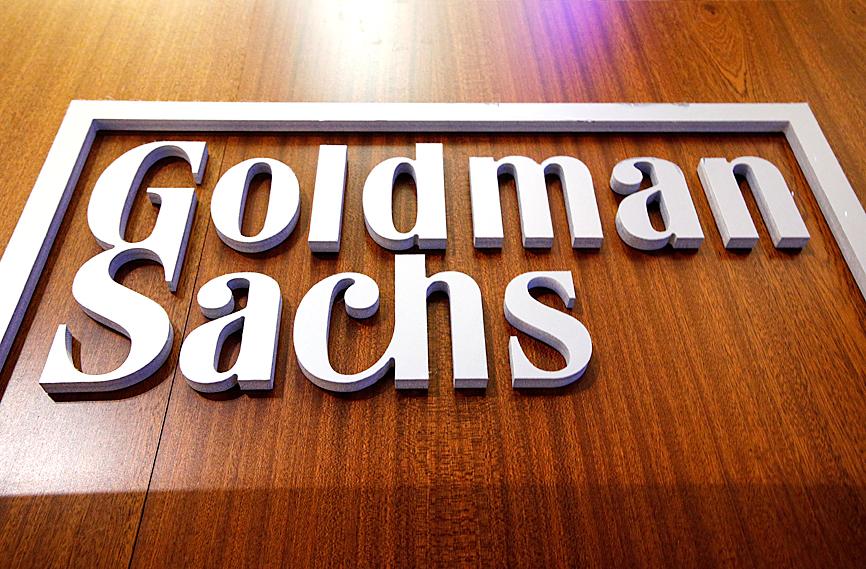Profit at Goldman Sachs Group Inc jumped amid a merger boom, while JPMorgan Chase & Co’s results were boosted by the impact of the recovering US economy on loan quality, according to results released on Tuesday.
The financial heavyweights reported soaring second-quarter profit compared with the previous year, when large banks set aside massive reserves in case clients defaulted amid the COVID-19 downturn.
However, widespread access to COVID-19 vaccines and the accelerating reopening of the US economy have put those days in the rearview mirror.

Photo: Reuters
At JPMorgan, which has a significant retail operation in addition to investment banking, combined debit and credit card spending was up 45 percent from the previous year and more than one-fifth higher than in the pre-pandemic 2019’s second quarter, JPMorgan chief executive Jamie Dimon said.
He highlighted “exceptionally strong” consumer and business balance sheets.
However, the much sunnier outlook includes some continued question marks surrounding the course of the pandemic.
The rapid spread of the Delta variant of SARS-CoV-2 is one factor creating “elevated uncertainty” about the bank’s outlook for “a very robust recovery,” JPMorgan chief financial officer Jeremy Barnum said.
Goldman Sachs chief executive David Solomon also cited the pandemic as a potential source of economic trouble, noting this month’s tightening of restrictions in Hong Kong and Australia.
Vaccine coverage “is not consistent across communities and nations, including parts of the United States,” Solomon said on a conference call with analysts. “Widespread vaccine distribution and high vaccine rates are critical to open and thriving economies.”
The biggest US bank by assets, JPMorgan began the earnings season for the sector, reporting that profit more than doubled to US$11.9 billion in the second quarter, including a boost from US$3 billion that had been set aside as reserves.
JPMorgan had budgeted US$8.9 billion for bad loans in the second quarter last year, but it reported just US$734 million in charge-offs for defaults in the second quarter this year.
However, revenue for the period fell 8 percent to US$30.5 billion, as the bank’s trading business saw much less activity compared with the previous year.
Bank executives also expressed little optimism about loan growth, given the healthy state of US consumer finances following government stimulus programs.
Loan growth is going to be “a little bit of a slog through the rest of this year,” Barnum told reporters.
While “unusually high” pay rates for credit cards are “a healthy thing for consumers, it does create a bit of a headwind for our loan growth,” he said.
JPMorgan posted record global investment banking fees of US$3.6 billion in the second quarter, driven by heavy merger and acquisition activity.
At Goldman, profit came in at US$5.3 billion in the second quarter, compared with US$197 million the previous year, when results were dented not only by provisions for bad loans, but from elevated legal costs.
Revenue was US$15.4 billion, a 16 percent increase and the second-highest quarterly revenue in the firm’s history after the first three months of this year.
Goldman’s results reflected a jump in financial advisory revenue due to a rise in completed mergers and acquisitions.

Nvidia Corp chief executive officer Jensen Huang (黃仁勳) on Monday introduced the company’s latest supercomputer platform, featuring six new chips made by Taiwan Semiconductor Manufacturing Co (TSMC, 台積電), saying that it is now “in full production.” “If Vera Rubin is going to be in time for this year, it must be in production by now, and so, today I can tell you that Vera Rubin is in full production,” Huang said during his keynote speech at CES in Las Vegas. The rollout of six concurrent chips for Vera Rubin — the company’s next-generation artificial intelligence (AI) computing platform — marks a strategic

REVENUE PERFORMANCE: Cloud and network products, and electronic components saw strong increases, while smart consumer electronics and computing products fell Hon Hai Precision Industry Co (鴻海精密) yesterday posted 26.51 percent quarterly growth in revenue for last quarter to NT$2.6 trillion (US$82.44 billion), the strongest on record for the period and above expectations, but the company forecast a slight revenue dip this quarter due to seasonal factors. On an annual basis, revenue last quarter grew 22.07 percent, the company said. Analysts on average estimated about NT$2.4 trillion increase. Hon Hai, which assembles servers for Nvidia Corp and iPhones for Apple Inc, is expanding its capacity in the US, adding artificial intelligence (AI) server production in Wisconsin and Texas, where it operates established campuses. This

US President Donald Trump on Friday blocked US photonics firm HieFo Corp’s US$3 million acquisition of assets in New Jersey-based aerospace and defense specialist Emcore Corp, citing national security and China-related concerns. In an order released by the White House, Trump said HieFo was “controlled by a citizen of the People’s Republic of China” and that its 2024 acquisition of Emcore’s businesses led the US president to believe that it might “take action that threatens to impair the national security of the United States.” The order did not name the person or detail Trump’s concerns. “The Transaction is hereby prohibited,”

Garment maker Makalot Industrial Co (聚陽) yesterday reported lower-than-expected fourth-quarter revenue of NT$7.93 billion (US$251.44 million), down 9.48 percent from NT$8.76 billion a year earlier. On a quarterly basis, revenue fell 10.83 percent from NT$8.89 billion, company data showed. The figure was also lower than market expectations of NT$8.05 billion, according to data compiled by Yuanta Securities Investment and Consulting Co (元大投顧), which had projected NT$8.22 billion. Makalot’s revenue this quarter would likely increase by a mid-teens percentage as the industry is entering its high season, Yuanta said. Overall, Makalot’s revenue last year totaled NT$34.43 billion, down 3.08 percent from its record NT$35.52